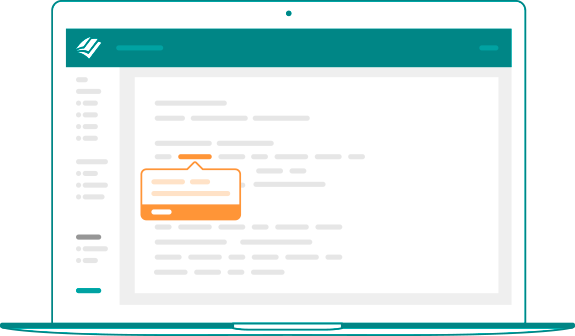
Transition Words and Phrases in English
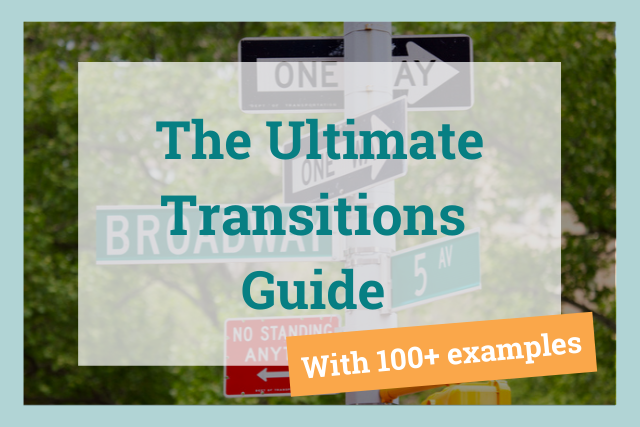
Imagine a road with no street signs to point the way. How would you follow the right route if you didn’t have a sign showing you which way to go?
Words and phrases like similarly, nevertheless, in order to, likewise, and as a result show the relationships between your ideas and can help illustrate agreement, contrast, or cause and effect.
What Are Transition Words?
Transition words are the road signs in writing. They help readers follow your train of thought without becoming bogged down trying to discern your meaning.
When used correctly, they keep up the flow of your writing as you shift in meaning, tone, and ideas from one sentence or paragraph to another. Transition words clarify the relationship between what you just said and what you're about to say for your readers.
Here’s an example of a well-placed transition:
- Original: The boy kicked the ball into the street. A speeding car came around the corner.
- Rewrite: The boy kicked the ball into the street. At the same moment, a speeding car came around the corner.
The rewrite uses a transition phrase to show when the event happened. We see the action in a wider lens: the ball goes into the street just as a car comes careening around the corner. The first illustration is short and choppy. It doesn’t flow well. The rewrite leads you smoothly between two related, but different thoughts.
The addition of at the same moment also clarifies the connection between the ideas for the reader. Since we know these events are connected and happening at the same time, we feel more tension for what's about to happen.
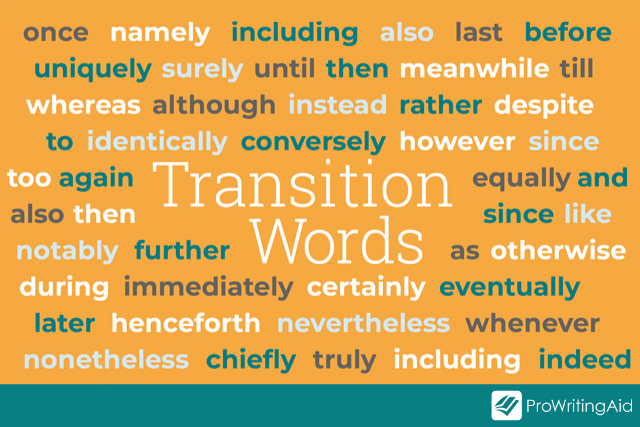
Transitional Words Examples: Fiction
Let’s take a look at some of these words in context to better examine how they work.
Fiction Transitions Example 1:
Take the following two sentences. Which one reads more fluidly?
- Mark tended to avoid the campus dining hall where his former friends hung out. He loved its food.
- Mark tended to avoid the campus dining hall where his former friends hung out, although he loved its food.
In the second construction, you understand how the two ideas are related. The first construction reads as choppy, two disparate ideas connected solely by proximity. By adding the transition word although and combining the two sentences, the second construction makes it clear that avoiding the dining hall had consequences for Mark. It gives more meaning to both sentences.
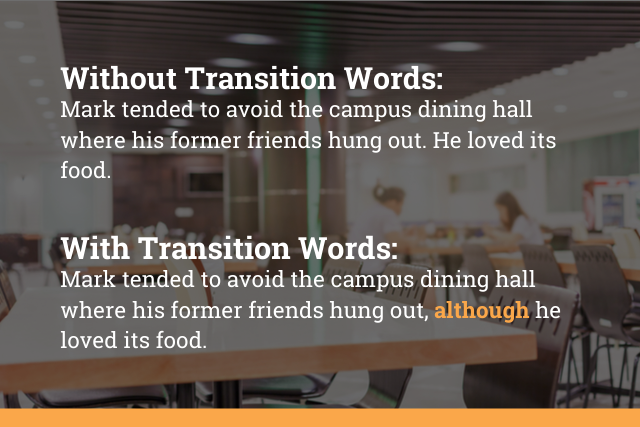
Fiction Transitions Example 2:
Here’s another example of transition word usage in fiction writing:
- Mindy thought her mother was over-reacting to her predicament. She waited two days after the first phone call to visit.
- Mindy thought her mother was over-reacting to her predicament. So, she waited two days after the first phone call to visit.
The use of so in the second construction makes clear to the reader that the gap in time between the call and the visit was a direct result of the over-reaction.
Transitional Words Examples: Non-Fiction
Transitions don’t just help fiction readers. Let’s take a look at how you can use transitions to improve your non-fiction writing.
Non-Fiction Transitions Example 1:
Take the following two constructions. Which one reads more fluidly?
- Marketing numbers have performed worse than we expected this year. We will be hiring a marketing consultant.
- Marketing numbers have performed worse than we expected this year, so we’ll be hiring a marketing consultant.
In the second construction, you understand how the two ideas are related. You see straight away that the poor marketing results are the direct reason for hiring a marketing consultant. By adding this connection, the relationship between the two ideas becomes clear. Similarly, the second version flows better and feels less self-contained.
Non-Fiction Transitions Example 2:
Here’s another example of transition word usage in non-fiction writing:
- The recent rise in oil pricing has made gas more expensive for consumers. Food prices have skyrocketed.
- The recent rise in oil pricing has made gas more expensive for consumers. Similarly, food prices have skyrocketed.
The use of similarly in the second construction makes it clear that there’s a relationship between the two ideas. The first construction feels disconnected since one sentence focuses on gas prices and another on food. The second construction makes it clear that the two ideas are related based on how they affect prices for consumers.
What Are the 6 Examples of Transitions?
What makes these phrases different from other words? They all move your writing from one idea to another.
The specific word or phrase you choose for your writing will depend on the type of transition you want to make. Each category of transition has multiple words or phrases you can choose from. Later in this article, we’ll show you hundreds of transition words or phrases to suit every need.
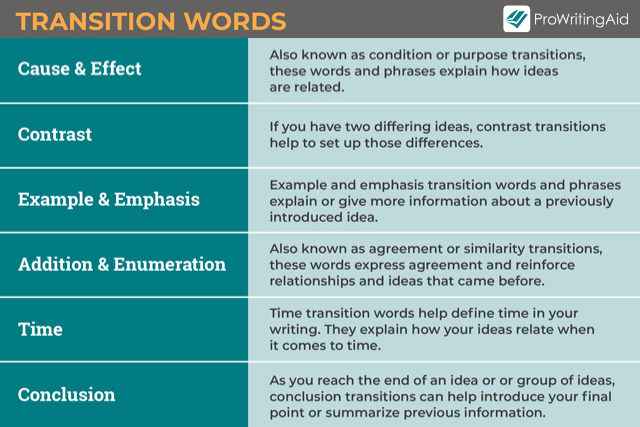
Before we get to the ultimate list of examples, let’s take a look at the categories.
Cause and effect: Show how two ideas are connected.
- I’m tired, so I’m going to bed.
Contrast: Show differences between two or more ideas.
- I hate most desserts. However, I love cookies.
Example and Emphasis: Introduce examples that help highlight or explain a previous point, or to add strength to a particular idea.
- I have a lot of fears. For instance, I’m terrified of spiders.
Addition & Enumeration: Break down, draw connections to, or add more support to an existing idea.
- Today, I’m going to do my homework. In addition, I’m going to clean my room.
Time: Explain how two or more ideas are related in time.
- Mary-Ann went out, looking for a bright new world. Meanwhile, Wanda looked all around their hometown and all she found was Earl.
Conclusion: Introduce a final point or summarize information.
- In conclusion, I deserve a new car because I’ve done all my chores for the month.
How ProWritingAid Can Help You with Transition Words
Clear, readable writing tends to use around 25% transition phrases. Of course this isn't set in stone—but if you have considerably fewer than this in your document, you may be losing your reader.
ProWritingAid's Transitions Report highlights all of the transition words in your document so you can see how your writing flows. Here's how it works:
Try out ProWritingAid's Transitions Report with a free account.
What Are Some Examples of Transition Words?
Looking for examples of transition words you can use in your writing? Look no further! We’ve put together the ultimate list with hundreds of examples you can use.
On to the list!
Cause and Effect Transition Phrases
Also known as condition or purpose transitions, these words and phrases explain how ideas are related.
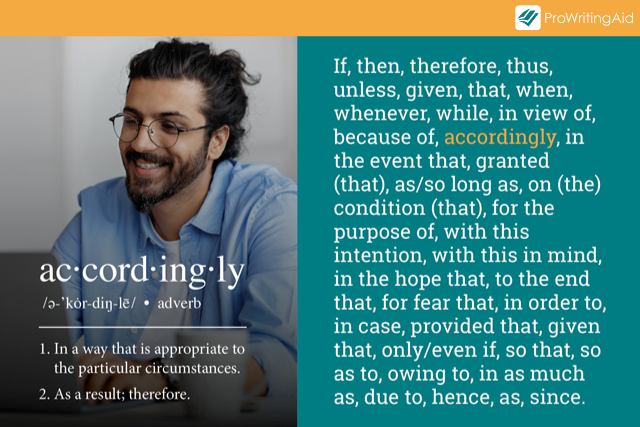
| if then therefore thus unless given that when whenever while in view of because of accordingly |
in the event that granted (that) as/so long as on (the) condition (that) for the purpose of with this intention with this in mind in the hope that to the end that for fear that in order to therefore |
in case provided that given that only/even if so that so as to owing to inasmuch as due to hence as since |
|---|
Contrast Transition Words
If you have two differing ideas, contrast transitions help to set up those differences.
| in contrast different from of course ..., but on the other hand on the contrary at the same time in spite of even so/though be that as it may then again |
but (and) still unlike or (and) yet while albeit besides as much as even though |
although instead whereas despite conversely otherwise however rather nevertheless nonetheless |
|---|
Example and Emphasis Transition Words
Example and emphasis transition words and phrases explain or give more information about a previously introduced idea. Sometimes known as clarification transitions, these words help make your meaning more clear.
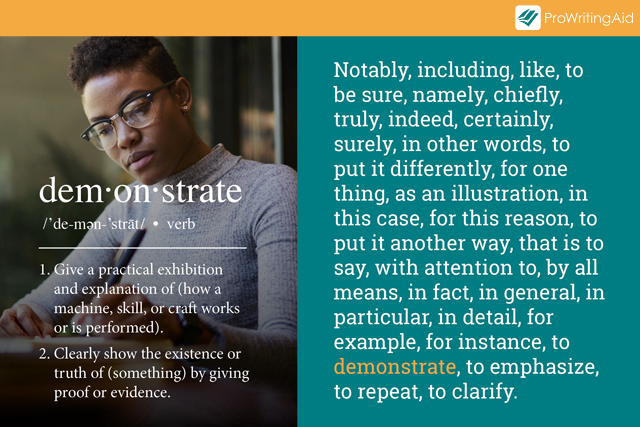
| notably including like to be sure namely chiefly truly indeed certainly surely |
in other words to put it differently for one thing as an illustration in this case for this reason to put it another way that is to say with attention to by all means |
in fact in general in particular in detail for example for instance to demonstrate to emphasize to repeat to clarify |
|---|
Addition and Enumeration Transition Words
Also known as agreement or similarity transitions, these words express agreement and reinforce relationships and ideas that came before.
| moreover as well as together with of course likewise comparatively correspondingly similarly furthermore additionally equally important |
again to and also then equally identically uniquely like as too |
in the first place not only ... but also as a matter of fact in like manner in addition coupled with in the same fashion/way first, second, third in the light of not to mention to say nothing of |
|---|
Time Transition Words
Time transition words help define time in your writing. They explain how your ideas relate when it comes to time.
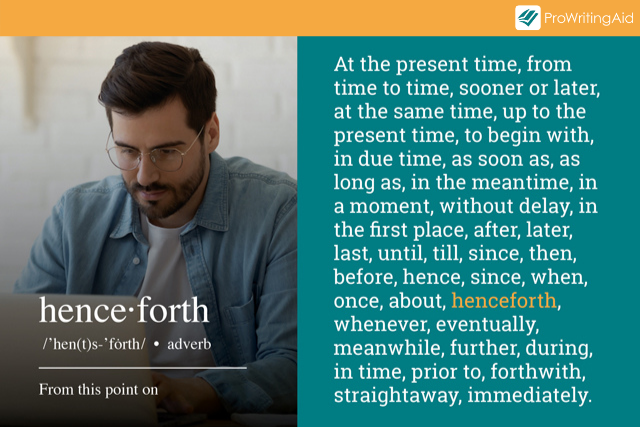
| at the present time from time to time sooner or later at the same time up to the present time to begin with in due time as soon as as long as in the meantime in a moment without delay in the first place |
after later last until till since then before hence since when once about |
henceforth whenever eventually meanwhile further during in time prior to forthwith straightaway immediately by the time whenever |
|---|
Conclusion Transitions
As you reach the end of an idea or or group of ideas, conclusion transitions can help introduce your final point or summarize previous information.
| as can be seen generally speaking in the final analysis all things considered as shown above in the long run given these points as has been noted in a word for the most part |
after all in fact in summary in conclusion in short in brief in essence to summarize on balance altogether |
by and large to sum up on the whole in any event in either case all in all usually obviously ultimately definitely |
|---|
How to Use Transition Words More Effectively
Using transition words and phrases isn’t always as easy as it looks. Here are some best practices to keep in mind so that you can effectively use transition words.
1. Understand the relationship between your ideas
The better you understand the relationships between the ideas in your text, the more effectively you’ll be able to wield transition words and phrases. The relationships between your ideas will help you understand which you should pick.
2. Know your transition words
Different transitions are appropriate in different contexts. Don’t just pick a random transition to use. Make sure the one you’ve chosen is appropriate for what you’re trying to say. Also, don’t be afraid to try out a new transition word from the list we’ve provided above. Just like in other types of writing, repetitive language can be boring for your readers. Try out new transition words (as long as they’re the right type) to increase the interest of your writing.
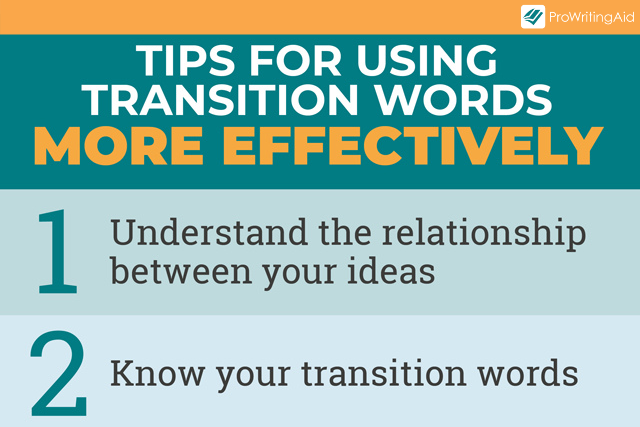
How ProWritingAid Helps You Improve Transition Words and Phrases in Your Writing
Since transitions help to organize your ideas and demonstrate connections, it’s important to include them in your writing to make it more clear. ProWritingAid can help. Our software analyzes your writing to determine whether or not you’ve used transitions appropriately in your work.
Depending on what you’re writing, you can find your Transitions score in two places: your goals and the Transition Report.
ProWritingAid knows that different genres require different amounts and types of transitions, so your suggested transition percentage changes depending on what you’re writing. If you’re working on an academic paper, for instance, transitional phrases are important to improving understanding. So you’ll find a goal for transitions in your sidebar.
On the other hand, formal transitions are less common in some types of fiction writing, so you may not see this goal if you’re working on say, a crime novel.
You can always find your score, regardless of what you’re writing, by running the Transition Report. The ProWritingAid Transition Report will scan your writing and give you a “transitions score." This measures the percentage of your sentences that begin with a transition word.
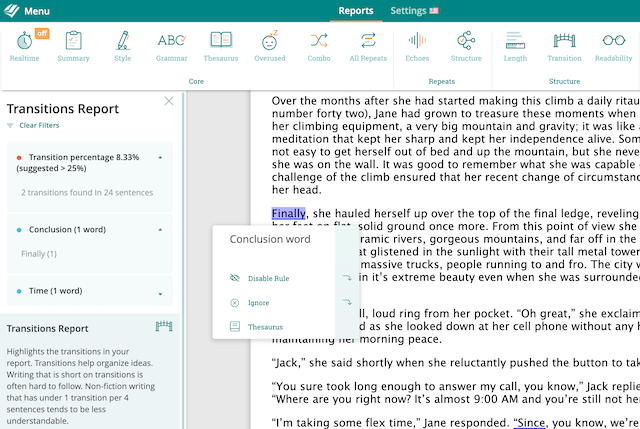
Check your transitions with a free ProWritingAid account.
Transitions: The Links Between Ideas
To conclude, great transitions lead to more sophisticated structure. (See what we did there with that transition?!)
Adding transitions to your writing creates clear connections for your readers. By adding transitions, you’ll help your readers better understand what you’re trying to say.
Happy writing!
Looking for more great editing advice? Download this FREE eBook:
Book cover: 20 Editing Tips From Professional Writers
Whether you are writing a novel, essay, article, or email, good writing is an essential part of communicating your ideas.
This guide contains the 20 most important writing tips and techniques from a wide range of professional writers.
Common Questions about Transition Words and Phrases in English
Transition Usage
Learn more about Grammar:
Adjectives: An Easy Guide with ExamplesAdverbial Clause: Definition, Meaning and ExamplesAdverbs: Definition, Meaning, Usage and ExamplesAnalogy: Definition & Meaning (with Examples)ArticlesBad Adverbs: What Makes an Adverb "Bad" and Why (with examples)Clauses: Definition, Meaning, and How to Use ThemConjunctions: Definition, Grammar Rules and ExamplesCoordinating Conjunctions: Definition, Meaning and ExamplesDangling ModifiersDeclarative Sentence: Definition, Meaning and ExamplesExaggerationHomophones: Definition and ExamplesInfinitivesInterjections: Definition, Meaning, and ExamplesIntransitive Verb: Definition, Meaning, and ExamplesNouns: Definition, Meaning and Types Explained (with examples)Participles PluralsPrepositional Phrase: What Is It & How to UsePrepositionsPronoun: Definition, Meaning and Types Explained (with examples)Split Infinitive: The Complete Guide (with Examples)Subordinate Clause: Definition, Types, and ExamplesSubordinating Conjunctions: What Are They? (with Examples in Sentences)The Complete Guide to Transitive VerbsTransition Words and Phrases in EnglishTypes of VerbsVerbs: Types of Verbs, Definition and ExamplesWhat Is Symbolism in Writing?Word ClassesYour Personal Writing Coach
A grammar guru, style editor, and writing mentor in one package.
Try for free today